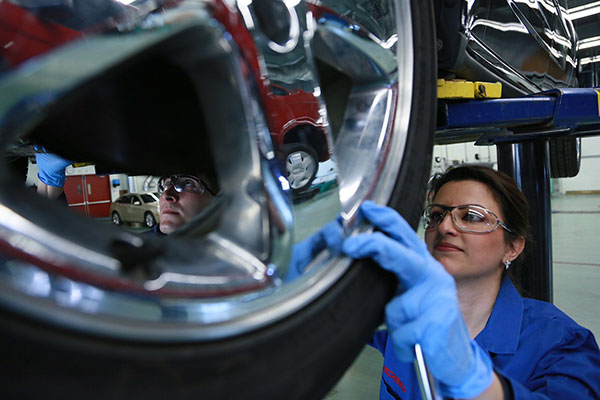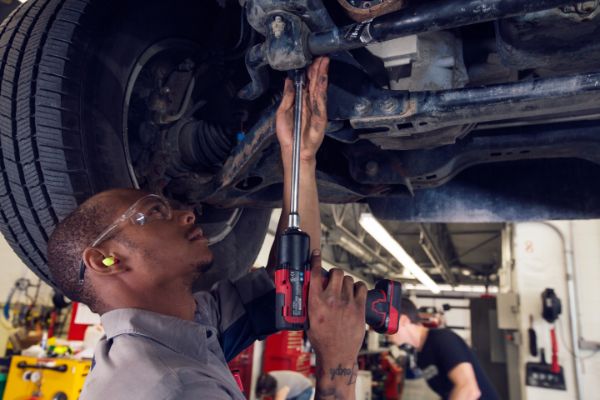On this page:
Overview
Want to work in an auto body repair shop? If you're looking for an alternative pathway into the auto body industry, our 12-week Pre-employment Auto Body program offers an excellent opportunity to kickstart your career.
This program will give you the fundamental skills needed for auto body repair. You will:
- learn the essential steps and techniques to prepare a vehicle for repair, including removing the paint finish, taping, sanding and masking
- discover how to prepare the surface of a vehicle properly
- gain expertise in applying fillers and undercoats, which are used to smooth out imperfections in the vehicle's surface
- get trained in component removal and installation, as well as detailing techniques to ensure the finished repair looks impeccable
- learn how to use tools and equipment safely and effectively.
As part of the program, you'll work in an operational auto body shop. This hands-on experience will allow you to apply your newly acquired skills in a real-world setting and gain practical knowledge that can set you apart in the job market.
Once you graduate, you'll be well-prepared to enter the auto body repair industry in an entry-level position. As you progress, you can become an apprentice and complete the required 3,400 work hours to earn your Alberta journeyperson certification as an auto body prepper. You can then choose to specialize further as an auto body refinisher or repairer or combine all three areas for certification as an auto body technician.
Whether you're seeking a new career path or looking to gain essential skills quickly, this program is designed to provide you with a strong foundation and practical knowledge to start your journey toward becoming a skilled auto body professional.
Those in the autobody field are objective, methodical and innovative.
You need:
- the strength and stamina required to handle heavy tools and parts
- manual dexterity
- creativity, patience and an eye for detail
- good colour vision
- computer skills
- customer services skills
- a commitment to safe work habits.
You should enjoy creative decision-making and performing tasks that require precision. You should be prepared to stay updated with the annual changes manufacturers make in plastics, electronics, metals, finishes and paints.
This program aligns with the first period of Alberta Apprenticeship and Industry Training's (AIT) Auto Body Technician curriculum.
Graduates are eligible to register as apprentices and challenge the first-period exam.
Once you pass the exam and complete the necessary training hours with an employer, you may register for SAIT's Auto Body Technician apprenticeship program beginning in period two.
You'll have the opportunity to apply the skills and knowledge learned in class with two weeks of work in an auto body mechanic shop.
After successfully completing this program, you'll receive a SAIT Pre-Employment Auto Body certificate.
Careers and opportunities
Each year, SAIT conducts a survey between February and April to determine the employment rate, salary and satisfaction of our newest SAIT alumni.
![]() 67% graduate employment rate
67% graduate employment rate
Find out more about our graduate employment statistics >
Our graduates may work in the following occupations. Some careers require additional experience and education.

Career planning support
Unsure which career path is for you? Here are some recommended career planning resources to help you decide your future.
You can also head to Alberta alis for lots of information about careers in Alberta, including quizzes and labour market information to help you narrow down a path.
Finally, you can take our online career finder quiz, which can help narrow your options based on your current skills and interests.
Courses
The Pre-Employment Auto Body certificate program requires 12 credits (5 courses) to complete.
| Course | Credits |
|---|---|
|
This is a theory course that delivers instruction on safety legislation, climbing, lifting, rigging and hoisting, hazardous materials and fire protection, apprenticeship training program, Alberta's industry network, interprovincial standards, safety at workplace, regulations that affect the trade, workplace coaching skills, and communication methods. |
3 |
|
The substrate preparation course discusses the foundations required to perform many of the entry-level auto body repairs. Topics covered include substrate identification, application of fillers, sanding, masking and application of undercoats. |
3 |
|
Advanced Hand Skills covers the theory and practice of auto body repairs. Using safe and environmentally friendly procedures and equipment, you will gain and apply the skills necessary to remove and install body components, perform the final detailing steps for a vehicle, prepare a vehicle for the application of topcoats and undercoats, and repair small dents. |
1.5 |
|
The course introduces the tools and equipment commonly used to perform basic auto body repairs in the industry and explores auto body components, methods used to fasten the components, and the removal and installation procedures. |
3 |
|
The Work Integrated Learning (WIL) component of the Pre-Employment Auto Body program gives you the opportunity to gain valuable real-world work experience in the industry. You'll complete two weeks of your program in an auto body mechanic shop, applying the knowledge you have learned in the program and gaining practical knowledge of workplace procedures and techniques. |
1.5 |
Progression
You must attain a PGPA and/or a CGPA of 2.0 or better each semester and pass the prerequisite courses to progress through the program.
To qualify for graduation, you must pass all courses, attain a CGPA of 2.0 or better and complete course requirements within the prescribed timelines.
Admission requirements
Applicants educated in Canada
Applicants must demonstrate English language proficiency and completion of the following courses or equivalents:
- at least 50% in English Language Arts 10-2, and
- at least 50% in Math 10-3, and
- at least 50% in one Grade 10 Science.
SAIT accepts high school course equivalents for admission for applicants educated outside Alberta.
All applicants who were educated outside of Canada must demonstrate English language proficiency and provide proof they meet the program admission requirements outlined above with an international document assessment. Find accepted educational documents and assessment options.
SAIT may also accept courses completed at certain international post-secondary institutions.

Academic Upgrading
Missing an admission requirement for this program? Upgrade your prior education to help you receive admission into one of SAIT's career programs.

English language proficiency
All applicants must demonstrate English language proficiency prior to admission, including students educated in Canada.
Transfer agreements
At SAIT, we evaluate post-secondary credit you have previously earned and apply it to your SAIT credential. Explore our formal transfer agreements available for this program.
We can evaluate your prior education, even if we don't have a formal agreement in place.
Submit a transfer credit application
There are no formal transfer agreements currently in place for this program.
Transfer options for graduates
Build on the knowledge you’ve learned at SAIT. The opportunity to advance your education at an accredited post-secondary institution may be available.
🔗 Visit Transfer Alberta search tool for all transfer agreements in Alberta (including UCalgary, MRU and BVC).
If there are transfer agreements with other institutions outside of Alberta, nationally or internationally, they will be listed below.
Available intakes
Spring 2025
Start dates:
- Domestic students: Waitlisted
-
-
Application deadline: April 30, 2025
-
Winter 2026
Start dates:
- Domestic students: Open
-
-
Application deadline: Oct. 24, 2025
-
Spring 2026
Start dates:
- Domestic students: Open
-
-
Application deadline: April 30, 2026
-
Costs
2025/26 tuition and fees
The following estimated costs are effective as of July 1, 2025.
The estimated total cost of tuition and fees is based on completing the program within 12 weeks. Following a modified schedule will impact the fees you pay per semester and may alter final costs.
Domestic students
**Students in this program do not qualify for the UPass or health and dental plans, nor do they pay Saitsa fees.
Books and supplies are approximately $1,000 per full-time year.
This is a bring-your-own-device program with a standard computer hardware and software requirement. See the specific requirements on our computers and laptops page.
Find your booklist on the SAIT Bookstore's website. The booklist will be available closer to the program start date.
Can't find your program or course? The bookstore didn't receive a textbook list. Contact your program directly to determine if they're still refining course details or if you're in luck; no textbook purchase is required this term.
Required personal protective equipment (PPE)
Steel-toe boots and safety glasses are recommended.

Financial aid
Paying for your education may feel overwhelming, but we have resources and programs that can help, including information about payment options, student loans, grants and scholarships.
This program is eligible for Canada Alberta Job Grant funding.
Application process
Ready to apply?
Follow our step-by-step guide to submitting a successful application.
Communication during admission
Email is the primary source of communication during the selection process. Ensure your personal email account is managed appropriately to receive our emails, files and communications. We recommend you add the transportation.info@sait.ca domain to your safe senders list or you risk missing critical email messages.

Begin your application
Apply now using the online application portal.
Ensure you have a valid Visa or Mastercard to pay the non-refundable application fee of $120 for domestic applicants.
Information sessions
Prepare for a strong start in your chosen program or get the details you need to decide your future path.
Our expert staff and faculty are ready to answer your questions and provide information about the following:
- What sets SAIT apart
- An introduction to the program and area of study
- Admission requirements
- Future career paths
- Information on the earning potential and graduate employment rates.
Contact us
School of Transportation Advising
-
Phone - 403.284.8471
Subscribe for updates
Your journey starts here! Sign up to get important updates on:
- Transportation and logistics programs
- Application information
- Relevant news and events

Oki, Âba wathtech, Danit'ada, Tawnshi, Hello.
SAIT is located on the traditional territories of the Niitsitapi (Blackfoot) and the people of Treaty 7 which includes the Siksika, the Piikani, the Kainai, the Tsuut’ina and the Îyârhe Nakoda of Bearspaw, Chiniki and Goodstoney.
We are situated in an area the Blackfoot tribes traditionally called Moh’kinsstis, where the Bow River meets the Elbow River. We now call it the city of Calgary, which is also home to the Métis Nation of Alberta.



